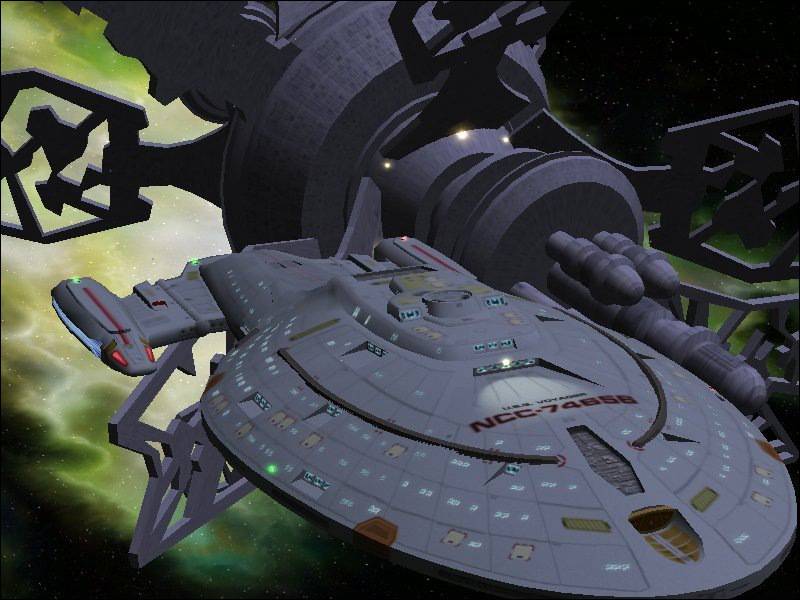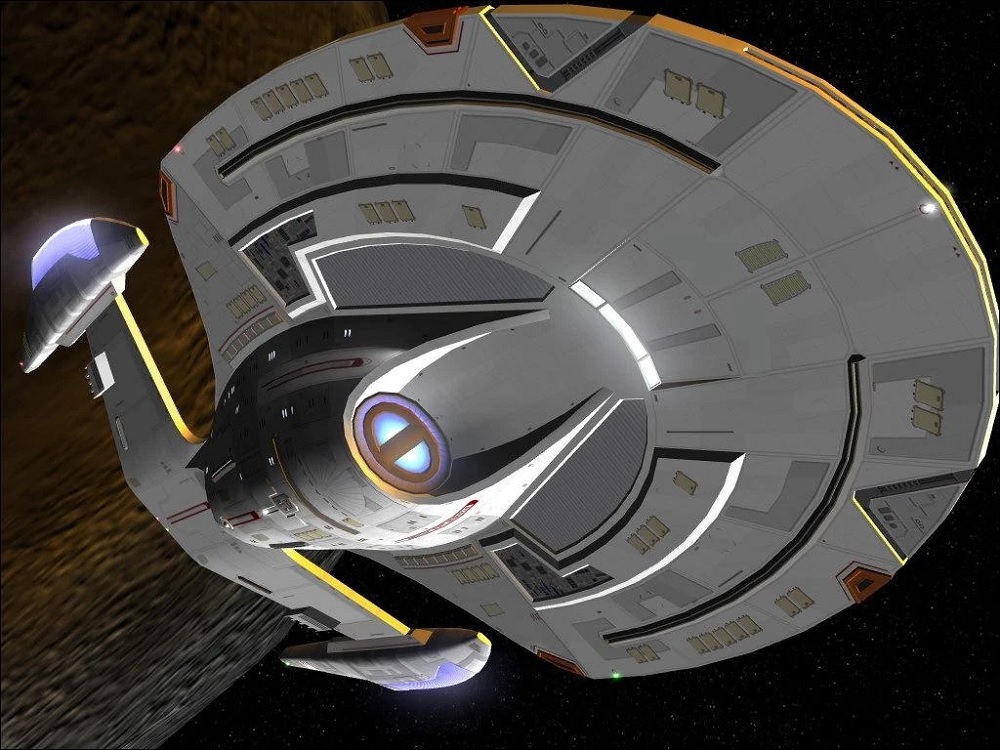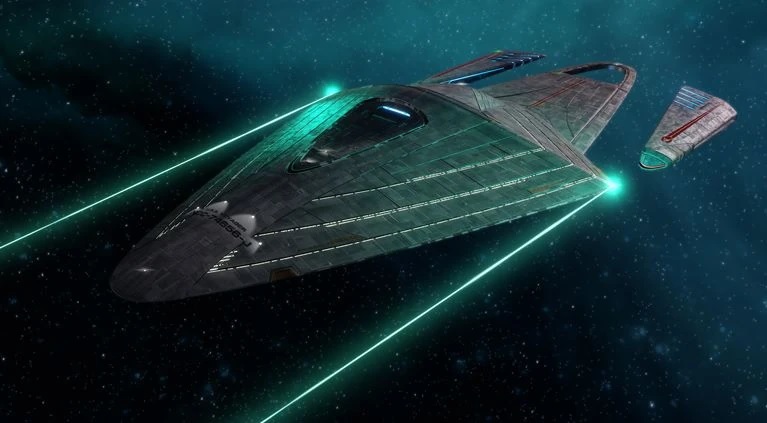Intrepid Class
Created by Fleet Admiral Luzol Targaryen on Tue Jul 25th, 2023 @ 11:48am
Intrepid Class
 | |
| Affiliation: | Federation Starfleet |
| Service Period: | 24th - 25th Centuries |
| Length: | 343 meters |
| Width: | 133 meters |
| Height: | 66 meters |
| Mass: | 700,000 metric tons |
| Decks: | 15 |
| Crew: | 150 personnel |
| Speed: | Warp 9.975 |
| Armament: | Phaser Arrays Torpedo Launchers |
| Defenses: | Multiphasic Shielding |
| Auxiliary craft: | Starfleet Shuttlecraft |
Overview
The Galaxy Class was everything that Starfleet Command had dreamed of and more. A well-armed, formidable exploration ship, the Galaxy Class was the most advanced ship that Starfleet had in its arsenal in the 24th Century. Unfortunately, Starfleet found itself using the Galaxy more frequently for Strategic and Diplomatic Operations than exploration. This, coupled with the resources needed to produce even a single Galaxy Class starship, led the Federation Science Council to petition the Advanced Starship Design Bureau for a smaller, more compact and streamlined vessel capable of assuming the Galaxy's mantle.
Authorized under the Perimeter Defense Directive, the new Intrepid Class would be comparable in size to the Constitution Class of the 23rd Century and fulfill a similar role to its predecessor. Borrowing heavily from technologies devised for the Nova Class, the Intrepid would have advanced exploratory and scientific capabilities compared to other ships its size. The Intrepid, as ordered, would be capable of excellent maneuverability at both impulse and warp speed and would be designed to conduct atmospheric and landing operations as needed. While construction of the Intrepid decreased during the Dominion War, it was quickly reauthorized for construction in the 2380s.
Capabilities
The exterior configuration of the Intrepid Class would have a lasting impact upon starship construction ideologies. The Intrepid features a smooth curves and a streamlined, ovoid-shaped primary hull that is directly integrated with the ship's cylindrical secondary hull. The most distinctive external advancement of the Intrepid Class was the inclusion of Variable Geometry Warp Nacelles into the design of the starship. Designed by the Theoretical Propulsion Group in response to the discoveries of the Hekaran scientists Rabal and Serova, the advancements to the Warp Drive of the Intrepid allow for the crew to adjust the vessel's warp field for maximum efficiency and stability. This further allows the Intrepid to safely travel at higher speeds for longer periods with fewer energy demands than in other core designs.During its design phase the Intrepid Class was selected to serve as the testbed for computer cores featuring bio-neural gel packs over the traditional isolinear systems in use by the Federation. The gel packs utilized bio-neural cells in their construction, which allowed for more efficient processing at higher speeds than previous generations of computer system. These bio-neural linkages had an unexpected benefit of allowing a starship to interpret information in similar method to a humanoid brain; nonetheless, they were susceptible to some viruses and biological infection unlike their duotronic and isolinear ancestors. The bio-neural technologies also improved automation aboard the Intrepid, reducing the overall crew requirements to a fraction of the nominal for a ship its size, and it also has an Emergency Medical Hologram installed to supplement the medical team.
Defense for the Intrepid is provided by Multiphasic Shielding generated by the Main Deflector installed along the forward section of the engineering hull, but a secondary deflector has been installed on the primary hull to enhance overall defense. While the Intrepid is armed with both phasers and photon torpedoes the starship was not designed to be a front-line combatant and is better suited for scientific missions. The Intrepid is configured with multi-spectral subspace sensors as standard equipment. The Intrepid has multiple laboratories available - from general purpose to specialized designs - to conduct both long and short-term research assignments. The Intrepid is outfitted with all available probe types as standard.
Refits and Variants
Shortly after the return of the U.S.S. Voyager to the Alpha Quadrant after having been lost in the Delta Quadrant for seven years, Starfleet Command ordered that the vessel be analyzed and advancements pioneered by the Voyager crew installed on future generations of Intrepid Class vessels. Sensor platforms aboard the Intrepid were expanded during this refit process and additional sensors were installed into the warp nacelles to enhance the capabilities of the variable geometry warp nacelles.
Mission Profiles
Explorer, Pathfinder and Reconnaissance Operations, Scientific and Survey Operations. The Intrepid Class features a dependable, rugged design that allows the ships of this class to be highly self-sufficient and capable of performing a variety of mission profiles. These benefits also allow the Intrepid Class to perform longer duration missions away from Federation territory.
Naming Conventions
Intrepid Class Starships are known for having naming conventions related to space exploration with vessels of the class commonly being named in honor of unmanned probes; however, some vessels also share names from mythology of Federation member worlds.
Notable Starships
U.S.S. Intrepid, Class Prototype U.S.S. Alliance U.S.S. Bellerophon U.S.S. Chimera U.S.S. Vor'kaan U.S.S. Voyager
Intrepid II Class
 | |
| Affiliation: | Federation Starfleet |
| Service Period: | 25th – 26th Centuries |
| Length: | 515 meters |
| Width: | 200 meters |
| Height: | 99 meters |
| Mass: | 1,050,000 metric tons |
| Decks: | 23 |
| Crew: | 400 personnel |
| Speed: | Warp 9.995 |
| Armament: | Phaser Arrays Torpedo Launchers |
| Defenses: | Regenerative Shielding |
| Auxiliary craft: | Starfleet Shuttlecraft |
Primary Shipyards
Overview
Capabilities
Refits and Variants
Mission Profiles
Naming Conventions
Members of the Intrepid II Class have naming conventions based on those of the United Earth Intrepid Class and are usually named in honor of historic vessels, lunar craters, or famous scientists from throughout the worlds of the Federation.
Notable Starships
U.S.S. Discovery, Class Prototype
Intrepid III Class
 | |
| Affiliation: | Federation Starfleet |
| Service Period: | 31st - 32nd Centuries |
| Length: | 452 meters |
| Width: | 174 meters |
| Height: | 86 meters |
| Mass: | 917,000 metric tons |
| Decks: | 20 |
| Crew: | 400 personnel |
| Speed: | Warp 9.995 |
| Armament: | Phaser Arrays Torpedo Launchers |
| Defenses: | Regenerative Shielding |
| Auxiliary craft: | Starfleet Shuttlecraft |
Primary Shipyards
Axanar Unified Industries, Axanar; Elysium Fields, Mars; Yoyodyne Propulsion Systems, Proxima
Overview
Aside from the Temporal Cold War and a few minor skirmishes, the United Federation of Planets enjoyed several centuries of relative peace throughout the Milky Way Galaxy. With 350 member worlds at its height, the Federation was able to return to its idealistic roots and Starfleet returned to its responsibilities as the Federation's exploratory, humanitarian, and peacekeeping armada. Despite its successes, a growing rise in tensions stemming from dilithium becoming scarce led the Federation to focus efforts on finding new sources of this vital element along with trying to find alternative propulsion options for the future.
Ordered alongside the Constitution V Class, the new Intrepid III was ordered by the Federation Council to bring hope to a weary galaxy. Intended for mid-level exploratory missions, the Intrepid III would focus on speed and maneuverability without having to sacrifice its scientific capabilities to meet these goals. While the Constitution V would become the symbol of Starfleet in the Post-Burn universe, the Intrepid III would find itself assuming responsibilities as the Federation's Flagship class from its larger cousin with the U.S.S. Voyager-J being designated as the Flagship of Federation Headquarters.
Capabilities
The Intrepid III Class Starship shares the sleek and streamlined design silhouette of its 24th Century predecessor and incorporates generations of innovation into its construction. The Intrepid III consists of two modules, a diamond shaped primary hull and a secondary hull housing the vessel's propulsion systems. Using innovative techniques designed to enhance a vessel's maneuverability, the Intrepid III features detached Warp Nacelles that remain connected to the ship through superconductor originating magnetic seals while at impulse speeds. Like its ancestor, the Warp Nacelles of the Intrepid III employ variable geometry configuration, leading the nacelles to connect to the hull of the vessel at a raised position while at Warp.Designed for tactical performance, the Intrepid III maintains a high capacity structural integrity field, higher than most of its contemporaries. The Intrepid III has been equipped with a Starfleet standard issue Cloaking Device, which allows the vessel to become invisible to the naked eye and all but the most sophisticated sensor systems. Due to the risk of the vessel encountering technologically advanced threats, the ships of the class have Regenerative Shielding for their primary defense during combat maneuvers. The Intrepid III has been outfitted with enhanced Phaser Arrays and a full load of Photon and Quantum Torpedoes for combat maneuvers.
Intrepid III Class vessels incorporate sensitive sensor arrays and navigational systems, allowing the ships of this class to serve as dedicated cartographers in uncharted space. Equipped with programmable matter reservoirs, Intrepid III Class vessels incorporate Isolinear Computer Cores and are supplemented by Interstitial Multivector TransComputronics (IMT-C and often pronounced ihm-tech) software devised by the Federation's Department of Temporal Investigations. In support of the variety of mission profiles that the Intrepid III can be assigned, members of this class have a large shuttlebay located on the ventral side of their secondary hull. With priority access to an extensive number of storage bays, the Intrepid III is an ideal choice to respond to disasters throughout the Federation and beyond.
Refits and Variants
Starfleet Command had no opportunity to launch a formal refit program for the Intrepid III Class vessel prior to the Burn.
Mission Profiles
Crisis and Emergency Response, Pathfinder and Reconnaissance Operations, Strategic and Diplomatic Missions. When ordered by Starfleet Command the Intrepid III was designed to complete midlevel exploratory missions; however, following the Burn, the Intrepid III was repurposed to respond to the needs of a devastated galaxy with exploration an afterthought.
Naming Conventions
Members of the Intrepid III Class have naming conventions based on those of the United Earth Intrepid Class and are usually named in honor of historic vessels, lunar craters, or famous scientists from throughout the worlds of the Federation.
Notable Starships
U.S.S. Kathryn Janeway, Class Prototype U.S.S. Al-Batani U.S.S. Discovery U.S.S. Pathfinder U.S.S. Voyager-JCategories: No categories found